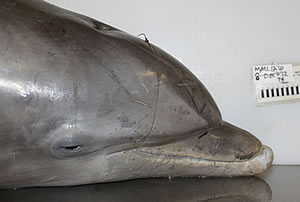
A bottlenose dolphin native to Sarasota Bay died after swallowing fishing gear.
A local bottlenose dolphin was found dead Saturday, Dec. 8, in Venice Inlet and examined by Mote Marine Laboratory scientists, who report that it most likely died from swallowing fishing gear. This case serves as a reminder to keep waterways clear of fishing line and other trash that can harm marine animals.
The female dolphin was 27 years old â€" relatively young â€" and was part of the year-round resident population of bottlenose dolphins in Sarasota Bay, according to the Sarasota Dolphin Research Program, a collaboration between Chicago Zoological Society and Mote that has monitored and studied the local population for 42 years. This dolphin, known as FB93, had been observed since 1985.
The dolphin was found floating in Venice Inlet, between Venice and Casey Key, by a local officer from the Sarasota County Sheriff's Office, who contacted Mote's Stranding Investigations Program and brought the dolphin's carcass to a boat ramp in Nokomis. Mote staff retrieved the carcass and brought it back to Mote's Sarasota facility for examination.
Results of the necropsy, or animal autopsy, suggest that FB93 most likely died from swallowing fishing gear. Fishing line was wrapped tightly and in a slip-knot around the dolphin's "goosebeak" â€" the flexible tube connecting the blowhole to the lungs, likely leading to asphyxiation. The line was stretched taught and connected to a hook embedded in the dolphin's "melon" (forehead). Mote scientists are awaiting lab results that may provide additional details about the animal's condition and demise. However, its case history suggests it had been thriving before it died.
"Except for the fishing line and hook, FB93 appeared to be in excellent condition," said Dr. Randall Wells, Director of the Sarasota Dolphin Research Program, the world's longest-running study of a dolphin population. "She was one of the largest resident females of Sarasota Bay, at nearly 9 feet long and 471 pounds, and her stomach was full of fish."
Wells and his team had documented that FB93 was born to resident dolphin "Squiggy" and had given birth to six calves over her lifetime. Squiggy, now 56 years old, the 20-year-old brother of FB93, and FB93's 3- and 6-year-old calves still live in Sarasota Bay. Her most recent calf, born in June, has not been found and is presumed dead following the loss of its mother.
"This premature loss of a relatively young, productive female in her reproductive prime comes as a blow to the resiliency and sustainability of the Sarasota Bay dolphin community," Wells said. Many Sarasota Bay dolphins have been harmed or even killed through negative interactions with humans, such as boat strikes, ingestion of, and entanglement in fishing gear and illegal feeding of wild dolphins.
Mote's Stranding Investigations Program has recovered 36 stranded or dead dolphins with signs of human interaction during 1984-2009. Of 10 dolphins stranded or found dead this year, three showed signs of human interaction, including Beggar, a local dolphin that developed an unhealthy habit of accepting food from humans after being fed illegally many times. Beggar was found dead in September, very near to where FB93 was recovered, bearing healed puncture wounds, broken ribs and other injuries that appeared to have come from boat strikes, hooks and fishing line in his stomach and other signs of ill health. Though Beggar's carcass was found decomposed and no specific cause of death could be pinpointed, his condition and his behavior observed by the Sarasota Dolphin Research Program suggested that interacting with humans played a major role in his ill health.
Interaction was not always a cause of death for the other animals recovered by Mote, but it is a major risk and a common concern in local waters. A study by the Sarasota Dolphin Research Program found dolphin-human interactions during 16 percent of survey days, when Program staff monitored the local dolphins from a research boat, with about five percent of the resident dolphins involved. Another Program study observed dolphins "patrolling" on about 10 percent of survey days. Patrolling means milling or traveling back and forth within about 65 feet of boats, fishing lines or piers. FB93 had been observed patrolling six times since 2000. Lessening dolphin-human interaction is a key focus of the Sarasota Dolphin Research Program and much of Mote's education and outreach surrounding marine mammals. Bottlenose dolphins and other marine mammals are protected by the U.S. government through the Marine Mammal Protection Act and are an important part of local ecosystems.
